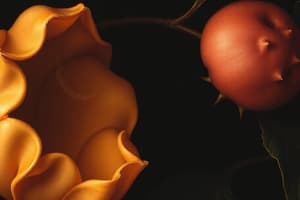Podcast
Questions and Answers
Which structure in a dicot embryo eventually develops into the plant's root?
Which structure in a dicot embryo eventually develops into the plant's root?
- Epicotyl
- Hypocotyl
- Plumule
- Radicle (correct)
What is the fate of seeds in which the endosperm is completely consumed during embryo development?
What is the fate of seeds in which the endosperm is completely consumed during embryo development?
- They are called ruminate seeds.
- They develop convoluted endosperm.
- They become endospermic or albuminous seeds.
- They store food reserve in the cotyledons and are called nonendospermic or exalbuminous seeds. (correct)
What is the role of the suspensor in dicot embryo development?
What is the role of the suspensor in dicot embryo development?
- To push the embryo into the endosperm for nutrient absorption (correct)
- To provide nutrients to the endosperm
- To initiate cell division in the zygote
- To protect the developing cotyledons
Which of the following represents the correct sequence of early dicot embryo development stages?
Which of the following represents the correct sequence of early dicot embryo development stages?
What part of the dicot embryo gives rise to the future shoot system?
What part of the dicot embryo gives rise to the future shoot system?
What is the function of the haustorium during early embryo development in dicots?
What is the function of the haustorium during early embryo development in dicots?
What distinguishes ruminate endosperm from other types of endosperm?
What distinguishes ruminate endosperm from other types of endosperm?
In dicot embryogenesis, the protoderm gives rise to which plant tissue?
In dicot embryogenesis, the protoderm gives rise to which plant tissue?
What role does the hypophysis play in the development of a dicot embryo?
What role does the hypophysis play in the development of a dicot embryo?
Which region of the developing dicot embryo gives rise to the hypocotyl?
Which region of the developing dicot embryo gives rise to the hypocotyl?
Flashcards
Embryogeny
Embryogeny
The sum total of changes that occur during the development of a mature embryo from a zygote or oospore.
Suspensor cell
Suspensor cell
The larger basal cell in a typical dicot embryo, which divides to form a filamentous structure.
Haustorium
Haustorium
The first cell of the suspensor towards the micropylar end, which becomes swollen and functions in nutrient absorption.
Hypophysis
Hypophysis
Signup and view all the flashcards
Protoderm
Protoderm
Signup and view all the flashcards
Procambium
Procambium
Signup and view all the flashcards
Epicotyl
Epicotyl
Signup and view all the flashcards
Plumule
Plumule
Signup and view all the flashcards
Hypocotyl
Hypocotyl
Signup and view all the flashcards
Radicle
Radicle
Signup and view all the flashcards
Study Notes
- Endosperm nucleus divides through transverse cytokinesis, forming two unequal cells: a larger micropylar cell and a smaller chalazal cell.
- The micropylar cell grows faster than the chalazal cell.
- Development in both cells resembles nuclear endosperm formation, resulting in a multinucleate stage followed by wall formation, like in Asphodelus.
- The chalazal chamber often stays smaller and can degenerate.
Fate of Endosperm
- During growth, the endosperm crushes the nucellus which is then consumed by growing embryo.
- In endospermic or albuminous seeds (e.g., Castor, Cereals, Coconut), the endosperm persists.
- In nonendospermic or exalbuminous seeds (e.g., Pea, Bean, Sunflower) the endosperm is fully absorbed, and food reserve is stored in cotyledons.
- Ruminate endosperm, seen in Areca and Passiflora, has a convoluted structure.
- Areca, Date (Pheonix), and Vegetable Ivory (Phytelephas microcarpa) have very hard endosperms.
- Cellulosic hard endosperm from vegetable ivory is used for making buttons, umbrella handles, and billiard balls.
Embryo – Structure, Types, and Development
- Embryogeny comprises all changes during the development of a mature embryo from a zygote or oospore.
Embryogeny in Dicots
- Zygote elongates and divides via a transverse wall into two unequal cells.
- The larger basal cell becomes the suspensor cell
- The suspensor cell divides transversely to form a filamentous suspensor of 6–10 cells, pushing the embryo into the endosperm.
- The first suspensor cell towards the micropylar end swells and functions as a haustorium, featuring wall ingrowths.
- The last suspensor cell adjacent to the embryo is known as the hypophysis.
- Hypophysis develops the radicle and root cap.
- The embryo cell undergoes two vertical divisions (quadrant stage) and one transverse division to produce eight cells in two tiers (octant stage).
- Epibasal (terminal) cells generate the two cotyledons and the plumule.
- Hypobasal cells (near suspensor) form the hypocotyl, except for its tip.
- The eight embryonic cells divide periclinally to create an outer layer of protoderm or dermatogen.
- Inner cells differentiate into procambium (plerome) and ground meristem (periblem).
- Protoderm forms epidermis, procambium forms stele or vascular strand, and ground meristem forms cortex and pith.
- The early embryo has radial symmetry and is globular and undifferentiated, referred to as the proembryo.
- It transforms into an embryo featuring the radicle, plumule, and cotyledons.
- Two cotyledons differentiate from the sides with a faint plumule in the center making the embryo heart-shaped.
- Rapid cotyledon growth leads to elongation while the plumule remains a small mound of undifferentiated tissue.
Structure of Dicot Embryo
- Dicot embryo features an embryonal axis and two cotyledons.
- Epicotyl is the part of the embryonal axis above the cotyledons; it terminates with the plumule (future shoot).
- Hypocotyl is located below the cotyledons and terminates in the radicle (future root).
- A root cap (calyptra) covers the root tip.
Studying That Suits You
Use AI to generate personalized quizzes and flashcards to suit your learning preferences.




